Poor Man's' Watch Forum
More ![]() Thanksgiving
hijinks. Many
Thanksgiving
hijinks. Many ![]() s
>
s
>
Posted By: Ricky Lee McBroom
Date:
Sunday, 26 November 2006, at 3:33 p.m.
In keeping with the
theme of the weekend, I decided to teach The Twins all about rockets.
It worked smooth, except for the part where Haley disobeyed an order from the RSO (Range Safety Officer, namely me
), got a stern reprimand, and threw a tantrum.
Girls will be girls.

Anyway, a carefully planned launch by a Master Rocketeer goes like this. First, you pick a low-powered (and, oh, cheap and disposable
) model;
Don't tell your baby grand-daughter, though.

These were old competition models (A Streamer Duration), very light (6.5 to 6.8 grams), and reached perhaps 150 meters on the vintage Centuri 1/4A4-3M engines we used. They fly great!
We hung the first one in a tree, but gauged the wind perfectly on flight two..
..she recovered it successfully, and so Junior Rocketeer Hannah Curtis was certified into the Fraternity Of Old Model Rocketeers.
You then move to higher-powered rockets. This one is designed for a C (10 Nsec), though we used a B instead, an Estes B4-4.
This one flew great, too, reaching perhaps 300 meters. We could have recovered it, but chose not too, since it fell on the property of a grumpy neighbor.
The next we painted first. It's a max-perormance competition design, too, this one being D/E (24MM engines) Parachute and Streamer Duration. Estes airframe, hand-sanded airfoiled hard balsa fine, etc. After I recycled the 2 meters of Kevlar thread it sported from it's days in the ring (hey, this stuff is like US 50-cents/foot!), and glued on a launch lug, it was ready to go...
...No pics, unfortunately. Grabbing a lift-off pic of a full-E comp rocket is nearly impossible. Especially when it's packing a full load, as this one was.

We used an Aerotech E10-8, a full 40 Nsec engine - 10 Nsec average thrust over a 4 seconds span.
This is, of course, a scholarly way of saying that this thing really cooked.
It punched through to 2,000+ meters by flame-out, and coasted to perhaps 3,300 meters before deploying a 15-foot streamer. The hang time (timed with my trusty
Twincept was an impressive 4-1/2 minutes before it fell behind the treeline, perhaps a mile downrange.
Later, after the wind calmed, we broke out a Bigger Rocket;
This is was a Q & D engine waster that I'd assembled from spare parts years ago, and had never flown. Haley put a My Little Pony sticker on it, and we christined it 'The Pony'. The flight profile, alas, was.. errr, well, it was less than optimal.

It did a 'core sample'.
I used an A5-2 engine, and it should've been a full B. Ah well, I make my rockets strong, and after I surgically removed the damaged 50 MM of airframe, it was ready to fly again.
Much better on Estes D-12 power!
Our day ended on a sad note, however, as this one hung in a tree.
Ah well!
Still lotsa fun!

-Ricky
Messages In This Thread

} I built rockets as a kid, probably
} starting
at 10 years old or so. Then I
} got more interested in cars and other
}
things. Then..I discovered that the
} hobby is still going strong.
That's almost exactly the way it went down for me, too.
Indeed, 'tis the classic 'Born Again Rocketeer' profile.
![]()
} As a kid we used the Estes engines,
} mostly A and B
engines, before they
} even came out with a C.
Whoa! You must have started a few years before me. ![]() Or maybe I
stuck with it longer, as Estes was making the D12 before I abandoned rockets the
first time around.
Or maybe I
stuck with it longer, as Estes was making the D12 before I abandoned rockets the
first time around.
} In the photo is my largest rocket..
Sweet! Looks like a LOC Precision kit?
} ..built for my level I certification flight.
Being something of a contrarian, I passed my Level I cert
flight with an Estes kit. ![]() The first to ever do
so, I'm pretty sure.. heck, maybe still the only to ever do so.
'twas modified somewhat from stock, mind you, but still an Estes kit at heart.
The first to ever do
so, I'm pretty sure.. heck, maybe still the only to ever do so.
'twas modified somewhat from stock, mind you, but still an Estes kit at heart.
} ..38mm H and I size reloadable engines.
What a revolution those were! By the
time reloadable engines were released my son was a teenager, and our active
involvement in HPR was winding down. But I did invest in a full set, simply
because they were so much more cost-effective than disposable engines. My
Inner Scotsman couldn't resist. ![]() The only one I've got
left is an RMS-54/852 (54 MM, a 'light J' of 850 Nsec total impulse).
The only one I've got
left is an RMS-54/852 (54 MM, a 'light J' of 850 Nsec total impulse).
Someone else took this photo and I don't remember if the launch was with the H or I engine.
One day I also built a rocket to break the sound barrier. I bought an Aerotech F72, which is a lot of power for a 24mm diameter engine. I built a minimum diameter rocket, and added some fiberglass to try to keep the fins on. Computer simulations predicted Mach 1.4, but I'm not sure they are accurate above Mach 1.0. Once the engine ignited, the rocket was never seen again, it moved off very fast.
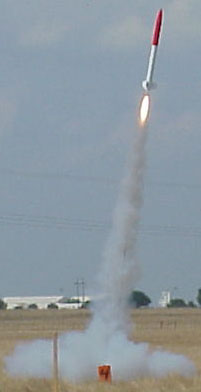
} Someone else took this
} photo..H or I
engine.
Great photo! Good rocket lift-off shots are tough. Nearly
as tough as watch photography. My most similar rocket is a North Coast kit, the Phantom. Here's a
liftoff shot on Aerotech J125 power:![]()

} I also built a rocket to
} break the sound barrier.
Not that tough to do, of course, except..
} ..added some fiberglass to
} try to keep the fins on.
..for that part. ![]() Keeping
surface-mounted fins attached to a supersonic model is not a trivial task!
Keeping
surface-mounted fins attached to a supersonic model is not a trivial task!
The rocket in my initial post (the one with the multi-colored hippy paint job ![]() ) used surface-mount
fins. And with a full E motor, that's definitely pushing it.
) used surface-mount
fins. And with a full E motor, that's definitely pushing it.
BTW, your addition of fiberglass reinforcement is a sound idea. I used a
similar technique to surface mount fins on a 54MM airframe;
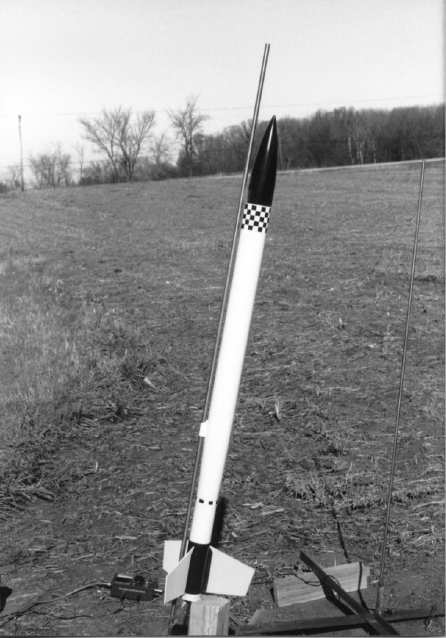
I used a layer of epoxy-soaked carbon fiber mat, wrapped completely around the
airframe, and 'L-brackets' of the same construction along the roots of the fins.
There were naysayers who said this would not survice, but it
worked just fine on the Aerotech I32 flight. I believe it could have survived a
full J, but never got the chance to prove it...
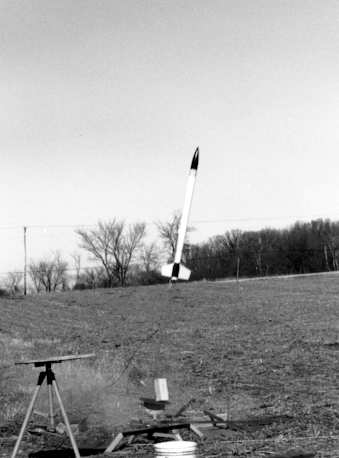
} Once the engine ignited, the rocket was
} never seen
again, it moved off very fast.
Next time put 'bout 1/4 cup of Zerox toner, folded loosely
in recovery tissue, right on top of the parachute. Wear gloves, it's messy! ![]()
![]()
The results are well worth it, though. That big black 'puff' of of Zerox
toner can be spotted from literally miles away! Some advocate less messy
alternatives, like powdered chalk. And it's OK, I use it sometimes. But for a
max-Q flight, where you've got to spot a small model at 5K+ meters, NOTHING is
better than Zerox toner. Accept no substitutes! ![]()
-Ricky
Whoa! Don't think I've ever made anyone "..remember the halcyon days of youth" before!
Sorry I totally overlooked that this was not a ![]() message the first time
through!
message the first time
through! ![]()
} I'm quite sure my daughter would
} enjoy some rocket
launching too.
See?! Kids are the perfect excuse to launch rockets again..
![]()
![]()
![]()
} My favorite engine was the C6-7.
Ah! A High-Power man at heart! ![]()
} It could cause you to lose lighter,
} smaller rockets
fast.
Yup. But with a 7-second delay, 'tis really a top-stage motor. As a single-stager, it should only be used with very light models!
} You made me remember the halcyon days of youth,
}
launching rockets with my best friend ...
Glad to be of service. ![]()
Tellya what.. Send me an ![]() w/ your return adress,
and I'll send you and your daughter a rocket. My Xmas present to y'all!
w/ your return adress,
and I'll send you and your daughter a rocket. My Xmas present to y'all! ![]()
-Ricky
I remember in particular the last time I launched some rockets. I had
acquired an Estes scissor-wing glider kit and spent almost a month assembling
and painting the rocket with silver paint, and trimmed in red. On it's maiden
flight I loaded it with a C6-5 (it was a heavy rocket) and tried to anticipate
the wind. I had too much angle on the launch tower, and of course a C6-3 would
have been a better choice for the engine. The rocket went ballistic, and the
deployment stage didn't fire until the rocket had fallen to 10 feet off the
ground with the nose aimed directly at the ground. The engine assembly puffed
out the back with a perfect chute deployment, the glider's wings snapped into
glide configuration just a fraction of a second before craterring into the
ground. ![]()
![]()
![]()
I actually believe that the deployment stage drove the rocket harder into the
ground. ![]()
A mint, vintage, sealed Scissor Wing kit out in a box in the
garage.. Interested? ![]()
I'll make ya a heck of a deal! Maybe a watch-for-rocket swap? ![]()
![]()
-Ricky

Pre-built, ready to fly! And great workmanship, if I do say so meself! ![]() I started
with 3/16" light balsa, and those wings have the most beautiful hand-sanded
airfoil you'll ever see!
I started
with 3/16" light balsa, and those wings have the most beautiful hand-sanded
airfoil you'll ever see! ![]()
Come on, trade me for a watch! I'm determined!
![]()
![]()
![]()
![]()
![]()
![]()
![]()
![]()
![]()
![]()
![]()
![]()
![]()
![]()
![]()
![]()
![]()
![]()
-Ricky
Go for it! ![]()
My son and I were really into if for 4 or 5 years. I mean totally immersed in it, National competitions and all.
I can't imagine a better way to spend time with the kids. My son learned more, and we grew closer together, sitting for long hours at the workbench building those models than any other activity we did as he was growing up.
Oh, and he's a 14 Tango (Patriot Missile system) in the US Army now, so I
guess it made an impact on his career choice. ![]()
-Ricky
More 'bout Ricky's
Rockets
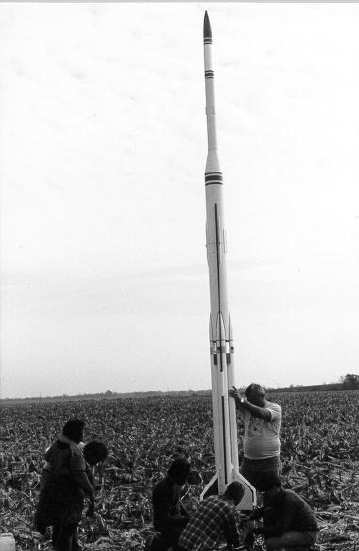
Until you've witnessed a K motor launch, you just don't
understand.. ![]()
BTw, the motors progress exponentially:
D = 20 Nsec
E = 40 Nsec
F = 80 Nsec
G = 160 Nsec
H = 320 Nsec
I = 640 Nsec
J = 1280 Nsec
K = 2560 Nsec
Estes (blackpowder) engines have always cut off at the D size, Centuri used to make E's. Some mavericks like FSI and Rocketflite used to make blackpowder G's.
Great fun, but all my engines above D nowadays are modern 'composite' fuel
motors. The fuel itself is polybutadine rubber. ![]() It has an embedded
crystallized oxygenator, amonium perchlorate. Very safe, the exact stuff the
Shuttle solids use. The biggest I've flown was an Aerotech reloadable, a
K1100-16. That's a 'light K' of some 1850 Nsec...
It has an embedded
crystallized oxygenator, amonium perchlorate. Very safe, the exact stuff the
Shuttle solids use. The biggest I've flown was an Aerotech reloadable, a
K1100-16. That's a 'light K' of some 1850 Nsec...
-Ricky
Thanks, Jeff!
This was The Ultimate Rocket, in case you missed it. NOT the K-powered scale
behemoth that is
technically my 'most powerful launch'.
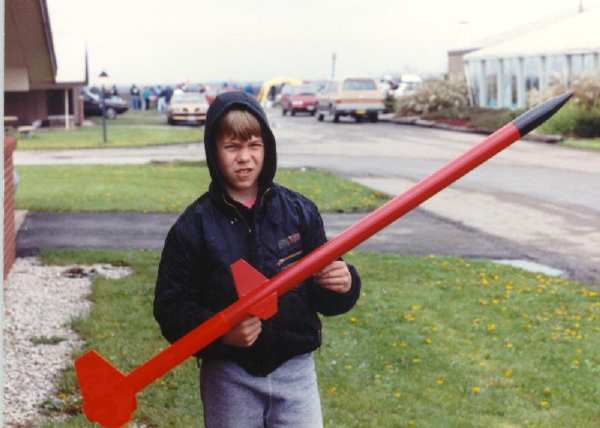
The H-Squared®
This was my semi-serious attempt at the I-Altitude record (and
I actually hoped to break the J record, too. If you're gonna dream, dream big.
![]() )
)
The key here, is that it's a 2-stage rocket. All the I-Altitude records on the books at the time used a single-stage, full 640 Nsec motor. These are 54MM in diameter, and demand a 100MM diameter airframe, if they are to survive.
By going to a 29MM full-H, and staging them, I could design around a 42MM airframe, and still have room for the through-the-wall fin construction that is crucial for a supersonic model.
Now, there was one snag. The only true full-H in 29MM is the Aerotech H125 (IOW a 2.56 burn time. 320 total Nsec/125 average Nsec=2.56). Fine for stage 1, where the idea is to clear the thick air quickly. But not so good for stage-2, where the idea is to accelerate less briskly through the thin air, but for a long time.
The optimal motor profile for the top stage, I determined through sims, was an H45. At 29MM, this would result in an engine length of 850+ MM. Barely possible from an airframe design standpoint, but made extremely problematic by the heat-resistance threshold of filament-wound composite case material.
I had a friend who made custom motors, and we determined that by going to a
2-layer casing, something like an 820 MM long H60 was theoretically possible.
Alas, that never happened and, while not the record-breaker I'd envisaged, my
max flight of H125-to-H125 was tracked to 7,000+ meters. And hit a conservative
Mach 2. ![]()
By contrast, the perfect flight profile** for the H125-to-H60 combo, according to the sims, was 16,000+ meters. That is over 50 thousand feet! Not exactly space, but when you consider this model is what amounts to a 1/8th-scale model of a professional sounding rocket, we're talking the equiv. of 75 MILES which is, of course, Space.
-Ricky
**Assumes:
1- Payload of 120 grams; radio direction transmitter, 1 x 200MM parachute, 1 x 20 meter streamer, 1 release-packet of Zerox toner
2- Burnout of stage 1 at 2.56 sec. ET
3- Release of spent stage 1 at 2.80 sec. ET
4- Coast of stage 2 in 'boosted dart' mode to 11.00 ET
5- Ignition of stage 2 at 11.00 ET
6- Coast of stage 2 in 'boosted dart' mode to release of parachute at 34.00 ET
50K feet in 34 sec. = a 1002 MPH average speed. ![]()
Suffice to say that I was serious enough about this endeavor that 'twas all
in Microsoft Project, complete with CAD models, reams of spreadsheet sims, etc.
![]()
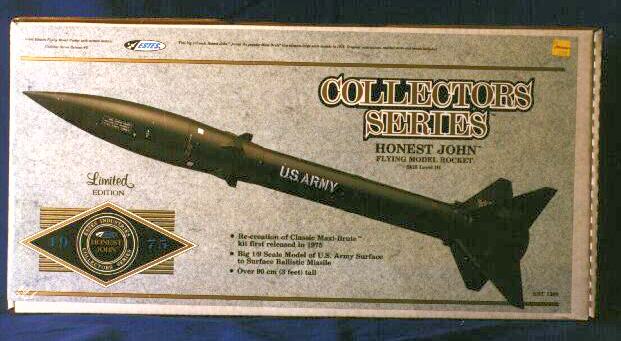
'cause I've got that exact kit out inna garage, too! ![]()
![]()
![]()
It's the late-80's reissue, though. More's the pity, as original '68-'70
versions in pristine condition have been known to fetch $250+ on ![]() !!
!!
Mine's worth maybe $100... ![]()
-Ricky
'Poor Man's' Watch Forum - Foro de Relojes Para el 'Hombre Pobre' - Horlogeforum voor de 'Arme Man'